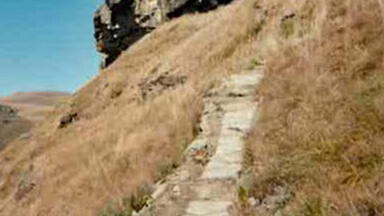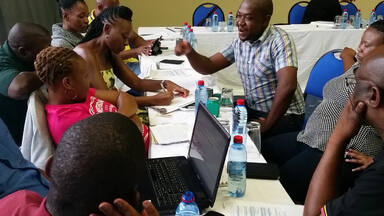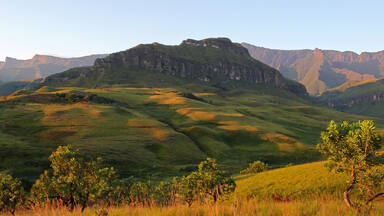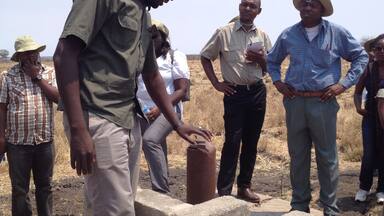Maloti-Drakensberg Park
Maloti-Drakensberg Park
The Maloti-Drakensberg Park is a transnational property composed of the uKhahlamba Drakensberg National Park in South Africa and the Sehlathebe National Park in Lesotho. The site has exceptional natural beauty in its soaring basaltic buttresses, incisive dramatic cutbacks, and golden sandstone ramparts as well as visually spectacular sculptured arches, caves, cliffs, pillars and rock pools. The site's diversity of habitats protects a high level of endemic and globally important plants. The site harbors endangered species such as the Cape vulture (Gyps coprotheres) and the bearded vulture (Gypaetus barbatus). Lesotho’s Sehlabathebe National Park also harbors the Maloti minnow (Pseudobarbus quathlambae), a critically endangered fish species only found in this park. This spectacular natural site contains many caves and rock-shelters with the largest and most concentrated group of paintings in Africa south of the Sahara. They represent the spiritual life of the San people, who lived in this area over a period of 4,000 years.
Description is available under license CC-BY-SA IGO 3.0
Parc Maloti-Drakensberg
Le Parc Maloti-Drakensberg est un bien transnational composé de l’uKhahlamba / Parc national de Drakensberg en Afrique du Sud et du Parc national de Sehlathebe au Lesotho. Le site offre une beauté naturelle exceptionnelle qui s’exprime tant à travers ses contreforts de basalte vertigineux, ses arrière-plans incisifs et spectaculaires et ses remparts de grès dorés que par ses grottes, falaises, piliers et bassins dans la roche. La diversité des habitats du site protège un grand nombre d’espèces de plantes endémiques et capitales au niveau mondial. Le site accueille des espèces menacées tel le vautour du Cap (Gyps coprotheres) et le gypaète barbu (Gypaetus barbatus). Le Parc national de Sehlathebe au Lesotho accueille également le poisson Cyprinidé (Pseudobarbus quathlambae), une espèce de poisson en voie d’extinction vivant exclusivement dans ce parc. Ce bien naturel spectaculaire compte également de nombreuses grottes et abris rocheux où l’on trouve le plus important et le plus dense groupe de peintures rupestres d’Afrique, au sud du Sahara. Ces peintures représentent la vie spirituelle du peuple San, qui a vécu sur ces terres pendant plus de quatre millénaires.
Description is available under license CC-BY-SA IGO 3.0
Parque Maloti-Drakensberg
source: UNESCO/CPE
Description is available under license CC-BY-SA IGO 3.0
マロティ‐ドラケンスバーグ公園
source: NFUAJ
Maloti-Drakensberg park
Source: unesco.nl
Outstanding Universal Value
Brief Synthesis
The Maloti-Drakensberg Park World Heritage Site is a transnational property spanning the border between the Kingdom of Lesotho and the Republic of South Africa. The property comprises Sehlabathebe National Park (6,500 ha) in Lesotho and uKhahlamba Drakensberg Park (242,813 ha) in South Africa. Maloti-Drakensberg Park World Heritage Site is renowned for its spectacular natural landscape, importance as a haven for many threatened and endemic species, and for its wealth of rock paintings made by the San people over a period of 4,000 years. The property covers an area of 249,313 ha making it the largest Protected Area complex along the Great Escarpment of Southern Africa.
The Maloti-Drakensberg Park range of mountains constitutes the principal water production area in Southern Africa. The areas along the international border between the two countries create a drainage divide on the escarpment that forms the watershed for two of Southern Africa’s largest drainage basins. The Thukela River from uKhahlamba Drakensberg Park flows eastwards into the Indian Ocean. The rivers of southern Maloti-Drakensberg including Sehlabathebe National Park drain into the Senqu/Orange River which flows westwards into the Atlantic Ocean extension of the uKhahlamba Drakensberg Park World Heritage Site to include Sehlabathebe National Park add special hydrologic qualities to the area.
With its pristine steep-sided river valleys and rocky gorges, the property has numerous caves and rock shelters containing an estimated 690 rock art sites, and the number of individual images in those sites probably exceeds 35,000. The images depict animals and human beings, and represent the spiritual life of the San people, representing an exceptionally coherent tradition that embodies their beliefs and cosmology over several millennia. There are also Rock art paintings dating back to the nineteenth and twentieth centuries, are attributable to Bantu speaking people.
Extending along most of KwaZulu-Natal’s south-western border with Lesotho, the property provides a vital refuge for more than 250 endemic plant species and their associated fauna. It also holds almost all of the remaining subalpine and alpine vegetation in the KwaZulu-Natal province, including extensive high altitude wetlands above 2,750 m and is a RAMSAR site. The uKhahlamba Drakensberg Park has been identified as an Important Bird Area, and forms a critical part of the Lesotho Highlands Endemic Bird Area.
Criterion (i): The rock art of the Maloti-Drakensberg Park is the largest and most concentrated group of rock paintings in Africa south of the Sahara and is outstanding both in quality and diversity of subject.
Criterion (iii): The San people lived in the mountainous Maloti-Drakensberg area for more than four millennia, leaving behind them a corpus of outstanding rock art, providing a unique testimony which throws much light on their way of life and their beliefs.
Criterion (vii): The site has exceptional natural beauty with soaring basaltic buttresses, incisive dramatic cutbacks and golden sandstone ramparts. Rolling high altitude grasslands, the pristine steep-sided river valleys and rocky gorges also contribute to the beauty of the site.
Criterion (x): The property contains significant natural habitats for in situ conservation of biological diversity. It has outstanding species richness, particularly of plants. It is recognised as a Global Centre of Plant Diversity and endemism, and occurs within its own floristic region – the Drakensberg Alpine Region of South Africa. It is also within a globally important endemic bird area and is notable for the occurrence of a number of globally threatened species, such as the Yellow-breasted Pipit. The diversity of habitats is outstanding, ranging across alpine plateaux, steep rocky slopes and river valleys. These habitats protect a high level of endemic and threatened species.
Integrity
The uKhahlamba Drakensberg Park, composed of 12 protected areas established between 1903 and 1973 has a long history of effective conservation management. Covering 242,813 ha in area, it is large enough to survive as a natural area and to maintain natural values. It includes four (4) proclaimed Wilderness areas almost 50% of the Park, while largely unaffected by human development, the property remains vulnerable to external land uses including agriculture, plantation forestry and ecotourism, although agreements between Ezemvelo Kwa-Zulu Natal Wildlife and local stakeholders have been implemented to manage these threats.
Invasive species, fire, infrastructural developments, soil erosion, tourist impacts on vulnerable alpine trails, and poaching also threaten the integrity of the site. The lack of formal protection of the mountain ecosystem over the border in Lesotho (beyond the buffer zone of Sehlabathebe National Park) exacerbates these threats.
Boundary issues highlighted at time of inscription included the gap belonging to the amaNgwane and amaZizi Traditional Council between the northern and much larger southern section of the Park. There are planning mechanisms that restrict development above the 1,650 m contour to maintain ecological integrity. Processes are underway to develop a cooperative agreement between the amaNgwane and amaZizi Traditional Council and Ezemvelo Kwa Zulu-Natal Wildlife. Extending conservation areas by agreements with privately-owned land along the escarpment to the south of the property is recommended. An important step to strengthening integrity has been the development of the Maloti-Drakensberg Transfrontier Conservation and Development Area (MDTFCA), which has recognised the importance of a Transboundary Peace Park linking the Sehlabathebe National Park (SNP) in Lesotho with uKhahlamba Drakensberg Park. Project Coordinating Committees in both KwaZulu-Natal and Lesotho are cooperating in a planning process. The SNP (6,500 ha) has been protected since 1970 as a wildlife sanctuary and a national park, and gazetted in 2001, to enhance protection of the biodiversity and scenic qualities of the property. The extension to include SNP has enhanced protection of the biodiversity and cultural values of the property.
The property contains the main corpus of rock art related to the San people in this area. A comparatively high concentration of rock art sites seems present in the western buffer zone in Lesotho and future surveys of these should be undertaken to judge their potential contribution to the Outstanding Universal Value. Although the area has changed relatively little since the caves were inhabited, management practices, such as the removal of trees (which formerly sheltered the paintings) and the smoke from burning grass both have the capacity to impact adversely on the fragile images of the rock shelters, as does unregulated public access.
Authenticity
The synthesis of rock art sites and their natural setting in the Maloti-Drakensberg Park convey a very strong sense of authenticity in setting, location and atmosphere but also material, substance and workmanship. It should be noted as a positive factor that in large parts of the property no systematic conservation or consolidation treatment has been attempted, which has left the rock art sites perhaps more fragile, but with the utmost possible degree of authenticity. The sites remain closely integrated with their surrounding landscape and credibly convey the narratives of San life and activity in respect to the harsh climatic conditions of the area and necessary exploitation of natural resources and shelter. This San rock art tradition does not terminate at the end of the Late Stone Age but continues, and is expressed at sites associated with both Khoi and Iron Age Peoples. Potential influences of UV rays and weathering on the images could lead to fading of colours and reduce the clarity of image content, which in turn could lessen their ability to display their meaning. It is important that explanatory materials assist the interpretation of the image content as understood by the San people.
Protection and management requirements
Management of the Park is guided by an Integrated Management Plan with subsidiary plans, and is undertaken in accordance with the World Heritage Convention Act, 1999 (South Africa, Act No. 49 of 1999); National Heritage Resources Act, 1999 (South Africa, Act No. 25 of 1999); National Environmental Management: Protected Areas Act, 2003 (South Africa, Act No. 57 of 2003); National Environmental Management Biodiversity Act, 2004 (South Africa, Act No 10 of 2004); KwaZulu-Natal Nature Conservation Management Amendment Act (South Africa, Act No 5 of 1999); the Game Preservation Proclamation (Lesotho, Act No. 55 of 1951); the Historical Monuments, Relics, Fauna and Flora Act (Lesotho, Act No. 41 of 1967); the National Heritage Act 2011 and Environment Act (Lesotho, Act No. 10 of 2008); World Heritage Convention Operational Guidelines; Environment policies in Lesotho and Ezemvelo KZN Wildlife policies. In terms of this legislation, all development within the property or within its buffer zone is subjected to an Environmental Impact Assessment and Heritage Impact Assessments respectively, which consider the Outstanding Universal Value of the property. In addition all World Heritage Sites are recognized as Protected Areas, meaning that mining or prospecting will be completely prohibited from taking place within the property or the proclaimed buffer zone. Furthermore, any unsuitable development with a potential impact on the property will not be permitted by the South African and Lesotho Ministers responsible for Environment and Culture.
Invasive species and fire are major management challenges. This poses a threat to the ecological integrity of the Park as well as to the yield of water from its wetlands and river systems. The interaction between the management of invasive species and the management of fire should also be carefully considered, taking into account the effects of fire on fire-sensitive fauna such as endemic frogs. Management of fire and invasive species needs is being addressed jointly by Lesotho and South Africa, ideally within the framework established for transboundary protected area cooperation.
There is a need to ensure an equitable balance between the management of nature and culture through incorporating adequate cultural heritage expertise into the management of the World Heritage property and providing the responsible cultural heritage authorities with adequate budgets for the inventory, conservation and monitoring tasks. This shall ensure that all land management processes respect the paintings, that satisfactory natural shelter is provided to the rock art sites, that monitoring of the rock art images is conducted on a regular basis by appropriately qualified conservators, and that access to the paintings is adequately regulated. Furthermore, there is a need to ensure that Heritage Impact Assessments are undertaken in conjunction with Environmental Impact Assessments for any proposed development affecting the setting within the property.
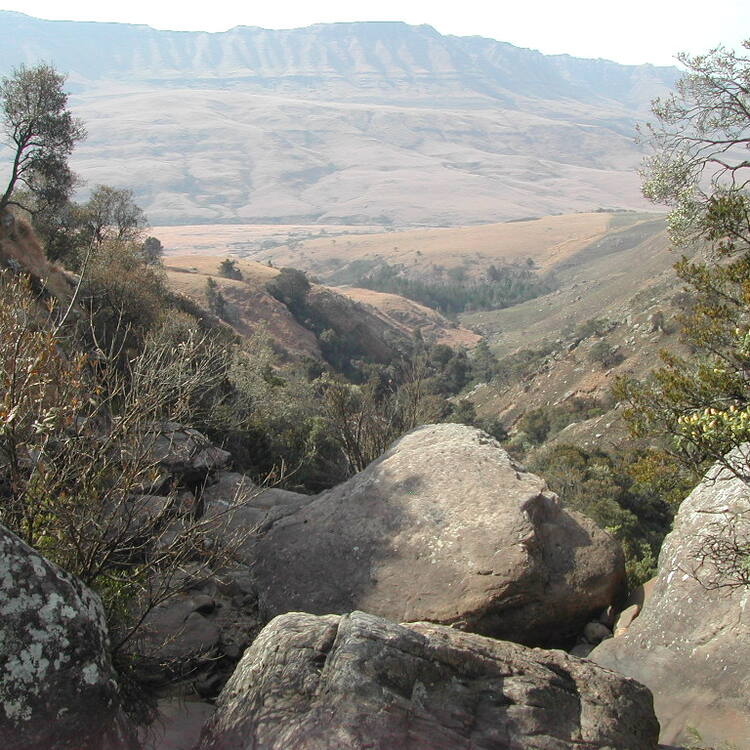
 View photos from OUR PLACE the World Heritage collection
View photos from OUR PLACE the World Heritage collection